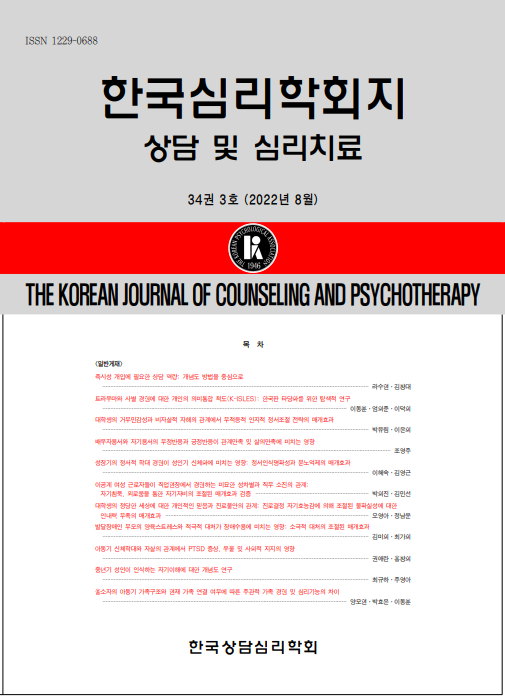open access
메뉴
open access
메뉴 ISSN : 1229-0688
ISSN : 1229-0688
본 연구는 상담관계에서 상담자들이 내담자의 수치심을 어떻게 지각하고 어떻게 개입하는 지, 이 과정에서 어떠한 경험을 하는지를 탐색하기 위해 수행되었다. 이를 위해, 한국상담심리학회 상담심리사 1급을 소지하거나 상담 경력이 10년 이상인 8명의 상담자를 대상으로 심층면접한 후 근거이론을 활용하여 자료를 분석하였다. 분석 결과, 82개의 개념과 31개의 하위범주, 14개의 상위범주가 도출되었다. 내담자의 수치심에 대한 상담자의 경험의 중심현상은 ‘내담자의 수치심을 다루는 것이 망설여짐’으로 나타났다. 패러다임 모형에서 중심 현상이 발견된 후, 시간의 흐름에 따라 과정분석을 실시하였다. 그 결과, 참여자들의 경험은 ‘동일시와 역전이 단계’, ‘알아차림과 이해 단계’, ‘접근과 지지 단계’, ‘성찰 단계’의 4단계로 나타났다. 마지막으로, 선택코딩 단계에서는 이전의 분석 결과를 통해 나온 개념들과의 관계를 설명할 수 있는 핵심범주로 ‘상담자의 존중하는 시선을 내담자가 내면화시킬 수 있도록 노력함’을 도출하였으며, 이러한 결과를 토대로 본 연구의 한계점, 후속연구에 대한 제언 및 상담에 대한 시사점을 논의하였다.
This study explores how counselors perceive and address client shame in the therapeutic relationship. Eight counselors, either holding Level 1 certification from the Korean Counseling Psychology Association or with over 10 years of experience, participated in in-depth interviews. Data were analyzed using grounded theory, yielding 82 concepts, 31 subcategoires, and 14 main categories. The central phenomenon was identified as ‘being hesitant to address client shame.’ After establishing this within the paradigm model, a process analysis revealed four stages: ‘identification and countertransference’, ‘awareness and understanding’, ‘approach and support’, and ‘reflection’. In the selective coding stage, the key category “efforts to internalize the counselor’s respectful gaze” emerged, linking previous findings and offering a comprehensive explanation of the process. Based on these results, the study discusses its limitations, implications for counseling, and suggestions for future research.
